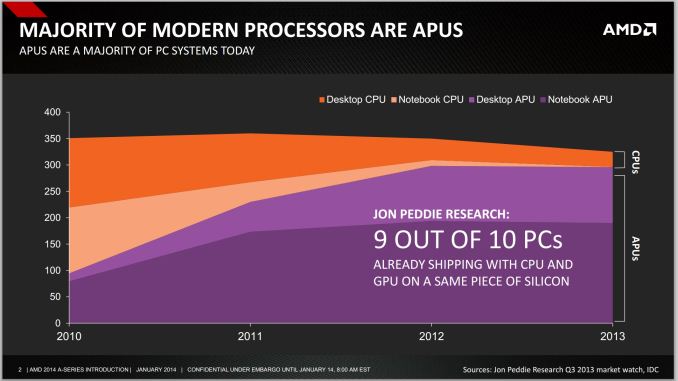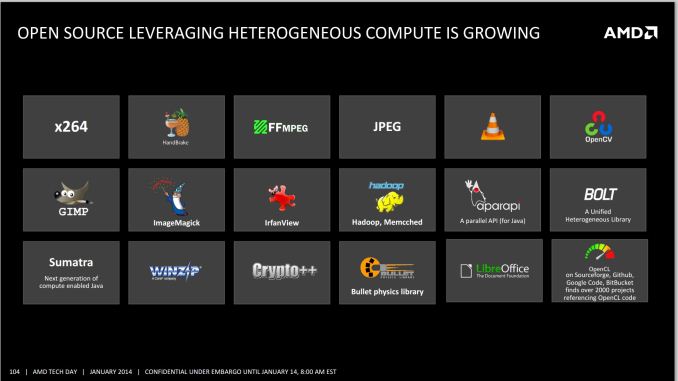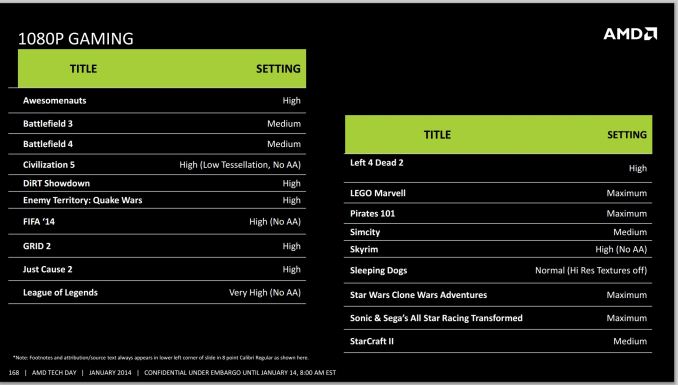AMD Kaveri Review: A8-7600 and A10-7850K Tested
by Ian Cutress & Rahul Garg on January 14, 2014 8:00 AM ESTKaveri: Aiming for 1080p30 and Compute
The numerical differences between Kaveri and Richland are easy enough to rattle off – later in the review we will be discussing these in depth – but at a high level AMD is aiming for a middle ground between the desktop model (CPU + discrete graphics) and Apple’s Mac Pro dream (offloading compute onto different discrete graphics cards) by doing the dream on a single processor. At AMD’s Kaveri tech day the following graph was thrown in front of journalists worldwide:
With Intel now on board, processor graphics is a big deal. You can argue whether or not AMD should continue to use the acronym APU instead of SoC, but the fact remains that it's tough to buy a CPU without an integrated GPU.
In the absence of vertical integration, software optimization always trails hardware availability. If you look at 2011 as the crossover year when APUs/SoCs took over the market, it's not much of a surprise that we haven't seen aggressive moves by software developers to truly leverage GPU compute. Part of the problem has been programming model, which AMD hopes to address with Kaveri and HSA. Kaveri enables a full heterogeneous unified memory architecture (hUMA), such that the integrated graphics topology can access the full breadth of memory that the CPU can, putting a 32GB enabled compute device into the hands of developers.
One of the complexities of compute is also time: getting the CPU and GPU to communicate to each other without HSA and hUMA requires an amount of overhead that is not trivial. For compute, this comes in the form of allowing the CPU and GPU to work on the same data set at the same time, effectively opening up all the compute to the same task without asynchronous calls to memory copies and expensive memory checks for coherency.
The issue AMD has with their HSA ecosystem is the need for developers to jump on board. The analogy oft cited is that on Day 1, iOS had very few apps, yet today has millions. Perhaps a small equivocation fallacy comes in here – Apple is able to manage their OS and system in its entirety, whereas AMD has to compete in the same space as non-HSA enabled products and lacks the control. Nevertheless, AMD is attempting to integrate programming tools for HSA (and OpenCL 2.0) as seamlessly as possible to all modern platforms via a HSA Instruction Layer (HSAIL). The goal is for programming languages like Java, C++ and C++ AMP, as well as common acceleration API libraries and toolkits to provide these features at little or no coding cost. This is something our resident compute guru Rahul will be looking at in further detail later on in the review.
On the gaming side, 30 FPS has been a goal for AMD’s integrated graphics solutions for a couple of generations now.
Arguably we could say that any game should be able to do 30 FPS if we turn down the settings far enough, but AMD has put at least one restriction on that: resolution. 1080p is a lofty goal to hold at 30 FPS with some of the more challenging titles of today. In our testing in this review, it was clear that users had a choice – start with a high resolution and turn the settings down, or keep the settings on medium-high and adjust the resolution. Games like BF4 and Crysis 3 are going to tax any graphics card, especially when additional DirectX 11 features come in to play (ambient occlusion, depth of field, global illumination, and bilateral filtering are some that AMD mention).













380 Comments
View All Comments
HanzNFranzen - Saturday, January 18, 2014 - link
Yea, 90% of people use Battlefield 4 90% of their time on the PC... You missed the question.keveazy - Saturday, January 18, 2014 - link
Doesn't matter.If you buy a PC, it's better to make sure it's solid and ready to handle applications that require strong physical cpu performance unless your still living the 90s dude.
My point is, AMD's highest end kaveri 7850k chip today is priced at the same range as Intel's low end i5 cpus. From here, you take your pic. If you wanna have a system that has worse graphics than ps4, go AMD.
kmi187 - Sunday, January 19, 2014 - link
If you've actually lived in the 90's you would know that cpu power was a lot more important back then than it is now. You didn't have hardware (gpu) acceleration for video and all that jazz to put less stress on the cpu.Also you do realize the PS4 runs on AMD hardware right?
medi02 - Tuesday, January 28, 2014 - link
What on earth are you talking about? What is a "solid PC"? One that fails at games?cryptik - Monday, March 30, 2015 - link
Today (30 Mar 2015) the AMD A8-7600 is the same price ($99) as the Intel Pentium G3460. The "lowest end" i5 CPU is $189. You're simply a liar who has no idea what he's talking about.vAngz - Sunday, January 26, 2014 - link
I believe you and others are missing the point. Can you play Battlefield 4 on medium settings @ 1080p using only the i5 4430, without using a discrete graphics card, and it still be playable above 30fps?Even though the chips are the same price (at most places), you can actually play BF4 using only the A10 7850K, which is not possible with the i5 4430. I bring this up mainly because you brought up BF4. When, rather if, Mantle is ever activated on BF4, things will change and we will see even better performance on the A10-7850K and later gen AMD APUs.
So, yes, you can get better performance out of the i5 4430, but you will need to spend more money on a discrete graphics card to use it for gaming, such as for BF4. I believe this what sets the AMD APUs apart from Intel offerings at the moment. We need to compare apples to apples.
I could be wrong, but I haven't seen anywhere in my research where anyone is getting that kind of performance out of i5 4430 without a discrete graphics card added into the mix. If you have a link on such info please share it with us. Thanks.
keveazy - Friday, February 7, 2014 - link
Your not getting it either. My mistake in my previous post is I didn't mention Battlefield 4 Multiplayer.That's where the APU will fail. It will fail in both the Cpu performance and Gpu performance. The APU is still the better choice at light gaming.
theduckofdeath - Wednesday, January 15, 2014 - link
I think he's referencing that processor simply because it's a pretty powerful, fairly low-priced processor for all of those who can live without all of those over-clocker tweaks...just4U - Tuesday, January 14, 2014 - link
You talk about 2500K performance and yet the majority of people I come across are not even working with that. The vast majority are still in the C2D/8800 like performance arena. What would be nice to see from some of these review sites in their performance analysis is if stuff like this makes sense to finally bite the bullet and get rid of the old dog..just4U - Tuesday, January 14, 2014 - link
Ian .. that's something I think you should look at btw.. we do get a fair number of lurkers /w some posting up questions like that about how it compares to the old warhorses their on. Hell even for those of us with old parts kicking around it's something to consider. Do we scrounge up some cheap ddr2 psu.. hand me down hard drives and pair it up for that box in front of the television or do we say no.. this makes far more sense and it's new.